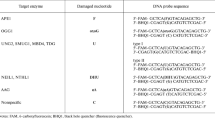Abstract
Reactive oxygen species (ROS) overproduction results in oxidative stress leading to genomic instability via the generation of small base lesions in the genome, and this unrepaired DNA base damage leads to various cellular consequences. The oxidative stress-mediated DNA base damage is involved in various human disorders like cancer, cardiovascular, ocular, and neurodegenerative diseases. Base excision repair (BER) pathway, one of the DNA repair pathways, is majorly involved in the repair of oxidative DNA base lesions, which utilizes a different set of enzymes, including endonuclease viz Apurinic/apyrimidinic endonuclease 1 (APE1). APE1 is a well-known multifunctional enzyme with DNA repair, REDOX regulatory, and protein-protein interaction/cross-talk functions associated with the cell survival mechanisms. APE1 acts as an important player in both normal and cancerous cell survival; thus, evaluating its endonuclease activity in the biological samples provide useful readout of the DNA repair capacity/ability, which can be used to tune for the development of therapeutic candidates via either stimulating or blocking its DNA repair function in normal vs. cancer cells, respectively. This chapter enlists two methods used for the determination of APE1’s endonuclease activity by oligonucleotide-based radioactive P32-labeled and nonradioactive fluorescence dyes using the cell extracts and recombinant APE1 protein.
Access this chapter
Tax calculation will be finalised at checkout
Purchases are for personal use only
Similar content being viewed by others
References
Fung H, Demple B (2005) A vital role for APE1/Ref1 protein in repairing spontaneous DNA damage in human cells. Mol Cell 17:463–470
Bhakat KK, Mantha AK, Mitra S (2009) Transcriptional regulatory functions of mammalian AP-endonuclease (APE1/Ref-1), an essential multifunctional protein. Antioxid Redox Signal 11(3):621–637
Mantha AK, Sarkar B, Tell G (2014) A short review on the implications of base excision repair pathway for neurons: relevance to neurodegenerative diseases. Mitochondrion 16:38–49
Thakur S, Sarkar B, Cholia RP et al (2014) APE1/Ref-1 as an emerging therapeutic target for various human diseases: phytochemical modulation of its functions. Exp Mol Med 46(7):e106–e106
Whitaker AM, Freudenthal BD (2018) APE1: a skilled nucleic acid surgeon. DNA Repair 71:93–100
Izumi T, Brown DB, Naidu CV et al (2005) Two essential but distinct functions of the mammalian abasic endonuclease. Proc Natl Acad Sci U S A 102(16):5739–5743
Friedberg EC, Meira LB (2006) Database of mouse strains carrying targeted mutations in genes affecting biological responses to DNA damage Version 7. DNA Repair 5(2):189–209
Xanthoudakis S, Curran T (1992) Identification and characterization of Ref-1, a nuclear protein that facilitates AP-1 DNA-binding activity. EMBO J 11:653–665
Xanthoudakis S, Miao G, Wang F et al (1992) Redox activation of Fos-Jun DNA binding activity is mediated by a DNA repair enzyme. EMBO J 11:3323–3335
Tell G, Quadrifoglio F, Tiribelli C, Kelley MR (2009) The many functions of APE1/Ref-1: not only a DNA repair enzyme. Antioxid Redox Signal 11(3):601–619
Kelley MR, Georgiadis MM, Fishel ML (2012) APE1/Ref-1role in redox signaling: translational applications of targeting the redox function of the DNA repair/redox protein APE1/Ref-1. Curr Mol Pharmacol 5(1):36–53
Mantha AK, Dhiman M, Taglialatela G et al (2012) Proteomic study of amyloid beta (25–35) peptide exposure to neuronal cells: impact on APE1/Ref-1’s protein–protein interaction. J Neurosci Res 90:1230–1239
Thakur S, Dhiman M, Tell G, Mantha AK (2015) A review on protein–protein interaction network of APE1/Ref-1 and its associated biological functions. Cell Biochem Funct 33(3):101–112
Sambrook J, Russell DW, Sambrook J (2006) Molecular cloning: a laboratory manual. Cold Spring Harbor Laboratory Press, Cold Spring Harbor, NY
Mantha AK, Oezguen N, Bhakat KK et al (2008) Unusual role of a cysteine residue in substrate binding and activity of human AP-endonuclease 1. J Mol Biol 379(1):28–37
Acknowledgments
This work was supported to A.K.M. by the funds recieved under BSR-start-up grant from the University Grants Commission (UGC), New Delhi, India, and the funds received under the scheme Research Seed Money (RSM) from the Central University of Punjab, Bathinda (CUPB). K.B.G and S.K. acknowledge financial support in the form of a senior research fellowship (SRF) from the Indian Council for Medical Research (ICMR) and University Grants Commission (UGC), Govt. of India, New Delhi, India. The Central Instrumentation Laboratory (CIL), CUPB, is thankfully acknowledged. Dr. Bibyendu Banerjee, Senior Scientist, Central Drug Research Institute (CDRI), Lucknow, India, is thankfully acknowledged for the technical training rendered for the fluorescence-based assays to K.B.G. Because of the limited focus of this article, many relevant and appropriate references could not be included, for which the authors apologize.
Author information
Authors and Affiliations
Corresponding author
Editor information
Editors and Affiliations
Rights and permissions
Copyright information
© 2022 Springer Science+Business Media, LLC, part of Springer Nature
About this protocol
Cite this protocol
Gupta, K.B., Kaur, S., Dhiman, M., Mantha, A.K. (2022). Methods to Assess Oxidative DNA Base Damage Repair of Apurinic/Apyrimidinic (AP) Sites Using Radioactive and Nonradioactive Oligonucleotide-Based Assays. In: Deep, G. (eds) Cancer Biomarkers. Methods in Molecular Biology, vol 2413. Humana, New York, NY. https://doi.org/10.1007/978-1-0716-1896-7_16
Download citation
DOI: https://doi.org/10.1007/978-1-0716-1896-7_16
Published:
Publisher Name: Humana, New York, NY
Print ISBN: 978-1-0716-1895-0
Online ISBN: 978-1-0716-1896-7
eBook Packages: Springer Protocols




